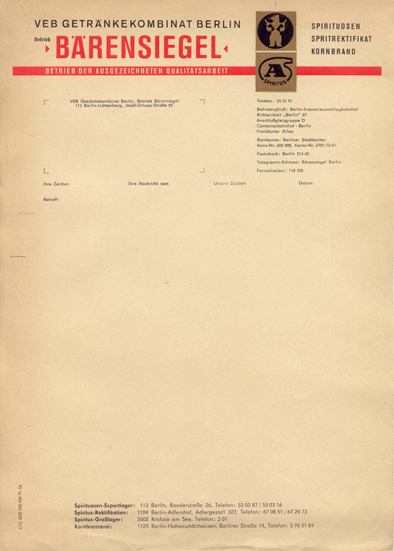VEB BÄRENSIEGEL [DE]
Exploration #201 VEB Bärensiegel. In the GDR, VEB Bärensiegel was one of the two largest suppliers of spirits. At the end of the GDR in 1989, VEB Bärensiegel produced around 26 million bottles of spirits with 400 employees.
VEB Bärensiegel Berlin was founded under the official name VEB Großberliner Getränkeindustrie on the 1st of March, 1949. The main headquarters were situated inside the former Research and Training Institute for Distillation in Berlin-Lichtenberg. On August 1950, the VEB was renamed into VEB Bärensiegel, and this date was then chosen as the official founding date.
During the duration of the GDR – the VEB Bärensiegel was one of the 2 largest spirit producers in East Germany, also partially due to the fact that it merged with other distileries. Later on the VEB merged into the Kombinat (Combination of various enterprises) Spirituosen, Wein und Sekt (Spirits, Wine, and Sparkling Wines). At its peak in 1989, the VEB employed over 400 workers and produced 26 million bottles of alcohol.
After the German reunification, the VEB was put under control of the infamous Treuhandanstalt and converted into a limited company which ran under the name Berlin BärenSiegel GmbH. The Treuhandanstalt sold off the company in 1994 to the Wine Company Franz Wilhelm Langguth Erben which proceeded to split up the company into different sections.
The production facilities in Lichtenberg and Adlershof were abandoned and all machinery has been removed from the buildings, whereas the facility in the Josef-Orlopp Straße was modernized and expanded. Interestingly enough, the Berliner BärenSiegel GmbH managed to quickly turn into a profitable company again, mostly due to drastically increased exports into the former eastern bloc. Bärensiegel products such as Wurzelpeter and Goldkrone that can still be found in supermarkets to this day.
Some of the buildings of the production facility in Adlershof were used as an Auto Repair shop after 1989, but they moved out sometime in the early 90s. The buildings were put under “Historic preservation” but have been left in their current state ever since. In 2020, the buildings were demolished and now a furniture shop stands in place of the distillery. Only the historic brick front façade was saved and incorporated into the new structure (source: https://digitalcosmonaut.com/).






















